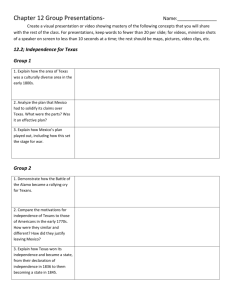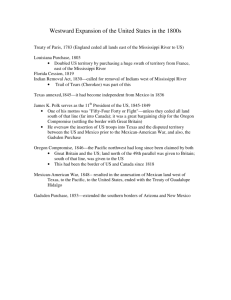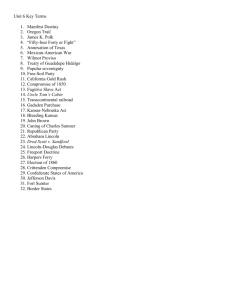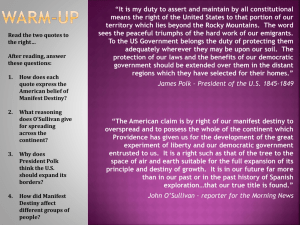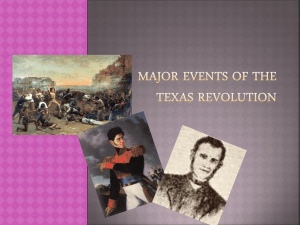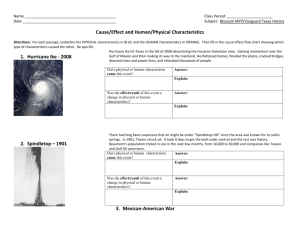Unit 5 Ppt. (1) - Expansion, Disunion, and Reconstruction
advertisement
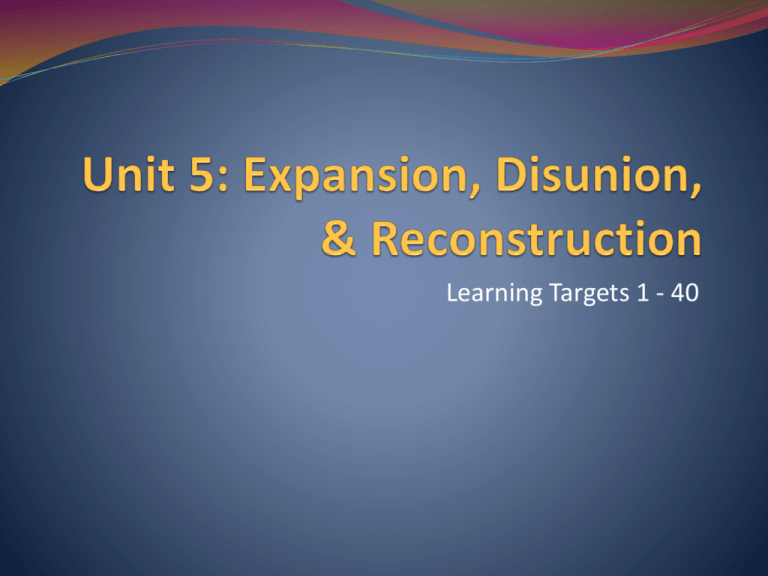
Learning Targets 1 - 40 1. I can define Manifest Destiny. •John L. O’Sullivan •Editor of United States Magazine and Democratic Review •described the annexation of Texas as: •“the fulfillment of our manifest destiny to overspread the continent allotted by Providence for the free development of our yearly multiplying millions.” •Manifest Destiny •the belief widely held by Americans in the 19th century that the United States was destined to expand across the continent! •acquiring Mexico & Canada 2 1. I can define Manifest Destiny. Imperialism the policy of extending rule or control of one country over other countries or colonies, territory, resources, people, etc… usually to control: natural resources markets naval bases Compare/contrast Manifest Destiny w/ Imperialism Are U.S. attitudes and policies in the world today, imperialistic? Middle East relations w/ China, Russia, etc… 3 1. I can define Manifest Destiny. John Gast American Progress 4 2. I can identify reasons for westward expansion. The “easy” purchase of Louisiana To obtain land for farming To increase “national security” To eliminate European influence from North America Britain in Canada Spain/Mexico in Mexico Belief in “ethnocentrism” belief that one’s own culture is superior to others as Christians, believe it is God’s will to spread across continent! Divine Providence 5 Quick Write Answer in complete sentences with many details and examples (O.I.) Define Manifest Destiny Explain at least two (2) reasons for westward expansion Explain how the idea of expansion might be present today in U.S. attitudes and policies around the world 6 3. I can discuss the conflict that occurred due to westward expansion. Texas Revolution - 1836 mass immigration (Moses/Stephen Austin) opposition to dictatorial rule of: General Antonio Lopez de Santa Anna Sam Houston and Texas Rebels fight for independence The Alamo Goliad Battle of San Jacinto Treaty of Velasco Oregon - 1845 threat of war with Great Britain “54/40 or fight!” peaceful settlement of border dispute at 49th parallel 7 8 9 10 3. I can discuss the conflict that occurred due to westward expansion. Mexican War - 1845-1848 brought on by “annexation” of Texas to the United States expansion of slavery in the U.S. distrust between U.S. and Mexico offer to purchase Mexican land seen as affront to Mexican people/nation U.S. seen as “imperialistic” border dispute settlement of claims California - 1848 hastily organized as “Bear Flag Republic” in midst of Mexican War became part of U.S. in Treaty of Guadalupe Hidalgo as well as approx. half of Mexico leads to Gadsden Purchase in 1853 11 12 13 4. I can explain the primary motive behind the Texas Revolution. Texas Revolution – 1836 Southerners immigrate into Mexico (Texas) land, escape US tariff policy, slavocracy, initially, settlers to: become citizens of Mexico obey Mexican laws convert to Catholicism after mass immigration, Mexico changes laws: suspend land grants place tariffs on goods from U.S. forbids slavery – 1829 14 4. I can explain the primary motive behind the Texas Revolution. Texas Revolution – 1836 Texan’s claim no representation in Mexican government tension over cultural differences Protestant Anglo settlers vs. Catholic Hispanic Mexicans English vs. Spanish language sugar/cotton farmers brought slaves to Texas Mexico abolishes slavery in 1829 Texans revolt for independence - 1835 15 5. I can examine the ways in which the Texas Revolution impacted the conflict between the North and South. Extension of slavery “slavocracy” in power in South feels itself a minority “section” of the nation being eclipsed by expansion of the North to the West Missouri Compromise upset balance of slave/free states North fears addition of slave state will tip balance in Senate in favor of slave states if reversed, endangered ability of the South to defeat antislavery measures in the Senate “Tallmadge Amendment” Fear of war with Mexico if annexed to the U. S. delays annexation 9 years 16 6. I can assess the legitimacy of the Texas border dispute that led to the Mexican-American War. 17 18 6. I can assess the legitimacy of the Texas border dispute that led to the Mexican-American War. 19 6. I can assess the legitimacy of the Texas border dispute that led to the Mexican-American War. 20 6. I can assess the legitimacy of the Texas border dispute that led to the Mexican-American War. Prior to Texas Revolution … … border between Texas and Chihuahua was Nueces River Treaty of Velasco … … ending the Texas Revolution, Texans force Santa Anna to accept Rio Grande as border between Independent “nation” of Texas (the Lone Star Republic), and Mexico with “gun to his head” under duress many argue Santa Anna, most if not all Mexicans, many in U.S., do not recognize Texas as independent as a result! Abraham Lincoln’s “spot resolution” 21 7. I can describe the role of President Polk in the MexicanAmerican War. James K. Polk President - 1845 – 1849 Southern slaveholder supported Manifest Destiny favored annexation of Texas “at the earliest practicable period” Slidell Mission John Slidell Spanish speaking emissary sent to Mexico by Polk to: purchase California and New Mexico reach agreement on Rio Grande as border between United States and Mexico Mission rejected by Mexican government U.S. insulted by treatment of Slidell Mexico insulted by offer to purchase much of territory and by annexation of Texas and border dispute 22 7. I can describe the role of President Polk in the MexicanAmerican War. Polk sends General Zachary Taylor … … into disputed territory between Nueces and Rio Grande Rivers … … and John C. Fremont into California both seen as violations by Mexicans of their territory Mexico sends troops across Rio Grande River … … skirmish ensues at Matamoros Mexico 11 U.S. soldiers dead Polk asks Congress for a declaration of war … … saying, “American blood has been shed on American soil!” Was Polk hoping for a conflict to justify war? 23 8. I can evaluate the political, economic, and social benefits of the Texas Revolution and Mexican-American War for the U.S.. Political Economic Social 24 9. I can evaluate the political, economic, and social loses of the Texas Revolution and Mexican-American War for the U.S.. Political Economic Social 25 10. I can explain the events of the Mexican-American War. Two Fronts Mexico Zachary Taylor defeats Santa Anna at Buena Vista in northern Mexico Winfield Scott conquers Veracruz and Mexico City California John C. Fremont leads military force to Salinas Valley Stephen Kearny “marches” from victory in New Mexico to California American settlers, led by Fremont, seize town of Sonoma and declare California independent Bear Flag Republic 26 10. I can explain the events of the Mexican-American War. Treaty of Guadalupe Hidalgo February 2, 1848 Terms: Mexico accepts Rio Grande as the border between U.S. and Mexico Mexico “cedes” territories of New Mexico and California to the United States U.S. agrees to pay $15 million for Mexican Cession includes present day states of California, Nevada, New Mexico, Utah, most of Arizona, parts of Colorado and Wyoming Guaranteed Mexicans freedom of religion, protection of property, bilingual elections, and open borders 27 10. I can explain the events of the Mexican-American War. 28 11. I can analyze the anti-war movement that occurred during the Mexican-American War. Abraham Lincoln Robert Toombs 29 11. I can analyze the anti-war movement that occurred during the Mexican-American War. U.S., increasingly divided by sectional rivalry … … the war was a partisan issue and an essential element in the origins of the American Civil War. Abraham Lincoln questioned the war’s justification “spot resolution” Abolitionists & Antislavery Whigs a plot to extend slavery ensure Southern domination of the Union Whig leader Robert Toombs of Georgia declared: “This war is nondescript .... We charge the President with usurping the warmaking power ... with seizing a country ... which had been for centuries, and was then in the possession of the Mexicans .... Let us put a check upon this lust of dominion. We had territory enough, Heaven knew.” 30 11. I can analyze the anti-war movement that occurred during the Mexican-American War. Charles Sumner Joshua Giddings 31 11. I can analyze the anti-war movement that occurred during the Mexican-American War. Charles Sumner “the lives of Mexicans are sacrificed in this cause; and a domestic question, which should be preserved for bloodless debate in our own country, is transferred to fields of battle in a foreign land.” Joshua Giddings … led a group of dissenters in Washington D.C. He called the war with Mexico "an aggressive, unholy, and unjust war," and voted against supplying soldiers and weapons. He said: “In the murder of Mexicans upon their own soil, or in robbing them of their country, I can take no part either now or here-after. The guilt of these crimes must rest on others. I will not participate in them.” 32 11. I can analyze the anti-war movement that occurred during the Mexican-American War. Henry David Thoreau David Wilmot 33 11. I can analyze the anti-war movement that occurred during the Mexican-American War. Henry David Thoreau … … was jailed for his refusal to pay taxes to support the war, and penned his famous essay, Civil Disobedience Wilmot Proviso – 1846 David Wilmot Pennsylvania Representative aimed to prohibit slavery in new territory acquired from Mexico Wilmot's proposal did not pass Congress, but it spurred further hostility between the factions 34 12. I can define popular sovereignty and explain its impact on the conflict between North and South Popular Sovereignty … “people power” … or, the sovereignty of the people the principle that the legitimacy of the state is created and sustained by the will or consent of its people, who are the source of all political power In Manifest Destiny … … the idea of allowing the people of a territory to decide for themselves to allow slavery to exist in their territory 35 12. I can define popular sovereignty and explain its impact on the conflict between North and South Impact … Compromise of 1850 popular sovereignty for Utah & New Mexico territories slavery not economically suitable so, little impact Kansas-Nebraska Act – 1854 popular sovereignty for Kansas & Nebraska territories immigrants rush/sent to populate territories to effect outcome produces mini-Civil War “Bleeding Kansas”, Pottawatomie Creek Massacre, John Brown, the “sack of Lawrence”, etc… so, significant impact 36 13. I can describe the role of Harriet Tubman in the abolition movement. 37 13. I can describe the role of Harriet Tubman in the abolition movement. 38 13. I can describe the role of Harriet Tubman in the abolition movement. Harriet Tubman – 1820 – 1913 was an African-American abolitionist, humanitarian, and Union spy during the Civil War she later helped John Brown recruit men for his raid on Harper’s Ferry in the post-war era, she struggled for women’s suffrage born into slavery … … Tubman escaped … … became a “conductor” on the Underground Railroad network of antislavery activists and safe houses made more than nineteen trips South to rescue more than 300 slaves including her own parents followed the North Star over Ohio River goal to reach Canada to ensure perpetual freedom 39 14. I can summarize the main message and describe the impact of Uncle Tom’s Cabin on the abolition movement. Harriet Beecher Stowe Uncle Tom’s Cabin – 1852 illustrated the evil and immorality of slavery illustrated slavery's effect on families family members sold apart, husbands from wives, children helped readers empathize with enslaved characters slave Eliza flees across frozen Ohio River, clutching infant son Uncle Tom purchased by kindly Augustine St. Clare demonstrated worst evils of slavery Uncle Tom whipped to death by wicked Simon Legree writing in the 1950s, poet Langston Hughes called the book a "moral battle cry for freedom." 40 14. I can summarize the main message and describe the impact of Uncle Tom’s Cabin on the abolition movement. 41 14. I can summarize the main message and describe the impact of Uncle Tom’s Cabin on the abolition movement. Impact North galvanized the abolition movement abolitionists increase protests against Fugitive Slave Act pass “personal liberty laws” demanded that the US deliver on the promise of freedom and equality contributed to the outbreak of the Civil War "So you're the little woman who wrote the book that started this great war.“ Abraham Lincoln South condemned it as an attack on the South stiffened Southern defense of slavery claimed that slavery was sanctioned in the Bible claimed it as a “positive good” that Tom was too noble a character and representative of the black race accused Stowe of fabricating unrealistic, one-sided images of Southern slavery 42 15. I can describe the role of John Brown in the abolition movement. 43 15. I can describe the role of John Brown in the abolition movement. John Brown - 1800 –1859 an American abolitionist who used violent actions to fight slavery began to hate slavery when witnessed a white man beating a young slave with a shovel devoted last 21 years of life to fighting for abolition Pottawatomie Creek Massacre - 1856 Brown's followers slaughter five pro-slavery men hacked off their hands, stabbed with broadswords contributed to “Bleeding Kansas” 44 15. I can describe the role of John Brown in the abolition movement. Harper’s Ferry Virginia – 1859 Led 18 men, black and white, to Harper’s Ferry Va. planned to seize the federal arsenal there distribute weapons to slaves in the area incite a slave rebellion throughout the South ended with his capture (by Robert E. Lee) trial resulted in his conviction and a sentence of death by hanging Effects some sympathy in the North thought of a martyr for cause of freedom terrified Southern whites who believed the North planned slave uprisings everywhere hastened the Civil War 45 16. I can evaluate the outcome of the Dred Scott case and its impact on the conflict between North and South. Dred Scott - 1857 Slave taken/lived in free states of Illinois and Wisconsin Constitutional question? was he free when moved to free states? Roger Taney SCOTUS Chief Justice from Maryland, a slave state Court was pro-slavery Decision Dred Scott not a citizen, but property non-citizens cannot sue in federal or any court! therefore, shouldn’t have been a case, yet … declared African-Americans to be an “… inferior class of beings, who had been subjugated by the dominant race, and, whether emancipated or not, yet remained subject to their authority.” “… they were so far inferior, that they had no rights which the white man was bound to respect.” 46 16. I can evaluate the outcome of the Dred Scott case and its impact on the conflict between North and South. Impact North abolitionists outraged aids newly founded Republican Party opposes slavery and its extension South joy, celebration indicates the government never able to restrict slavery or its extension contributes to split in Democratic Party results in Democratic Party becoming “minority” Party and loss in election of 1860 47 16. I can evaluate the outcome of the Dred Scott case and its impact on the conflict between North and South. Impact Dred Scott is property role of government is to protect property government cannot restrict where you can take your property therefore, … Provision of Northwest Ordinance prohibiting slavery in the Northwest Territory (1787) is UNCONSTITUTIONAL! Compromise of 1820 is UNCONSTITUTIONAL! Compromise of 1850 is UNCONSTITUTIONAL! Concept of “popular sovereignty” is UNCONSTITUTIONAL! 48 17. I can explain why the Republican Party chose Abraham Lincoln to be their candidate in the election of 1860. William H. Seward New York Senator leader of antislavery forces in Congress huge financial support from political organizations desire to be center of attention references to a “higher law” than the Constitution an “irrepressible conflict” between North and South Abraham Lincoln relatively unknown, appeared more moderate in views assured the South … he would not… “directly or indirectly, interfere with their slaves or with them about their slaves.” 49
